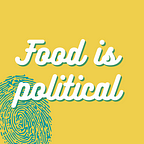Holier-than-thou
A clear way to drive a sharp wedge between a populace is via their belly. Food bans are not new, and we’ve seen them staining the globe every few months, almost like they’re on cue. Yet, we’ve learned very little about their efficacy.
For almost 1200 years, Japan observed a meat ban corresponding to the rise in Buddhism and its seepage into Shinto beliefs. Today, Wagyu beef from Japan is one of the most sought after varieties. Another instance occurred in 2011, where al-Shabaab in Somalia banned samosas due to their close resemblance to the Christian Holy Trinity. Some say that these popular crispy delights were banned due to reports of the meat stuffing being rotten. A much more controversial ban that led to a flurry in news stations across an entire continent and deeply impacted trade relations — was Russia’s ban on imported vegetables and cheese from Western Europe in 2014. Enforced in retaliation to hurt the European Union, it sent a message that couldn’t be interpreted in two ways — the EU must steer clear of its conflict with Ukraine. Despite the Kremlin’s stringent conditions, many cheese connoisseurs have found loopholes to import their favourite delicacies.
In India, one such sore and festering wound that keeps getting itched repeatedly is the beef ban. The ban is deeply rooted in its political history and lines the tainted paths of inter-faith and communal conflict. Each state in India has the autonomy to choose its law over the slaughter of meat, and the Hindi-speaking-belt of the country has traditionally opposed the slaughter of cow on account of religious sentiments. Maharashtra too amended the Maharashtra Animal Preservation Act, 1976, and caused significant uproar. The initial Act in 1976 expanded the ban on the slaughter of cows from Vidarbha to the entire state, and the Devendra Fadnavis led-government further amended Section 5D in 2015. The bill was expanded to include possession and sale of bulls and bullocks slaughtered within and outside the state. While the government managed to pacify a religious majority, let’s explore some unintended (but not unanticipated) consequences,
Illegal Trade
If you prod enough, you’ll soon find pockets of discrete people across Mumbai who know where to get good beef. Whether it’s the North of Malad, a posh school district, a quiet white bylane, or the busy thronged streets in the heart of the city — beef is everywhere. While I stick to my veggies nowadays, a few phone calls and generous references led to a blurry yet expansive network of beef suppliers in the city.
While the ban in 1976 in Maharashtra meant that most restaurants already served buffalo instead of cows, the data speak against the efficacy of the implementation of the ban. A study by the state’s forensic science laboratory showed positive results for beef in 488 out of 708 samples collected between 2015 and 2020. It’s the simple rule of the land, the moment you ban it, it goes and grows underground (Anyone smelling the whiff of whiskey from our dry states?).
Gau-rakshak led lynching
Conservation of the sacred animal has meant that there has been an increasing polarization between different communities. The Muslim, Tribal, and Dalit communities have often faced pressure to abandon their trade and eating habits to protect the sentiment of the religious majority. For some, it’s a trade that earned them their living, for others, it was a cheap resource to feed their family. In fact, Maulana Mehmood Madani of the Jamiat-e-Ulema-e-Hind called for a nationwide ban on beef to protect the community from repeated persecution.
Individual Autonomy
A crucial element circling the ban is the infringement of the Right to Privacy. Meat has long been a part of different community celebrations and cultural traditions. From a feast on the table to sacrifices for the Gods, animals have always intertwined closely with faith. In Nagaland, The ban on dog meat however triumphant in its protection of helpless animals — much like the holy cow — was an intrusion of a group of people who consumed it. Furthermore, it aggravated the seclusion of the Nagas (a majority of whom did not consume dog meat regularly) from the mainland due to the hyper-focused accusatory news.
Politics, climate change, trade, and religion have regulated what we eat for millenniums, and the debate on the bans is unlikely to end soon. Today, bans have made their way into the corporate world with companies such as WeWork banning it’s 6000 people strong workforce from expensing meals with meat and pledging to go meat-free for climate change.
While we may not always see eye-to-eye on the outright ban of food products, we need to introspect and come to a consensus behind the legitimacy of our bans. Are we on board with the homogenization of our eating and cultural practices, or are we dissenting with the hope of preserving our individual autonomy? And the most pressing question still remains — Do bans really work?
Let me know your thoughts.
References & Reads:
https://cjp.org.in/wp-content/uploads/2017/12/MAHARASHTRA-ANIMAL-PRESERVATION-ACT-1976.pdf
